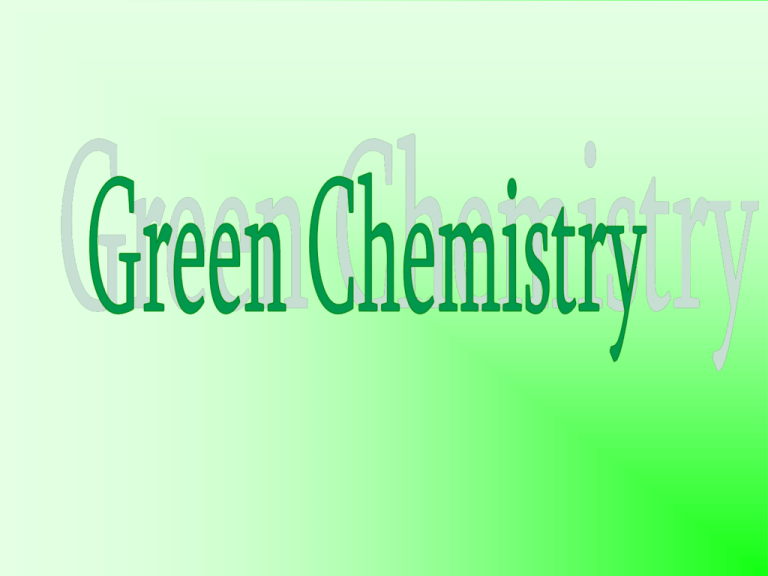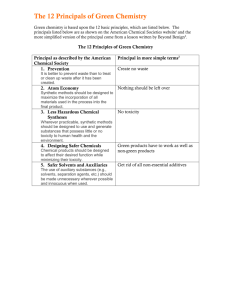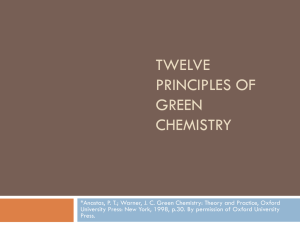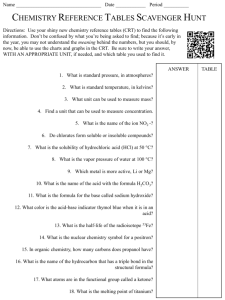green chemistry
advertisement

GREEN CHEMISTRY DEFINITION Green Chemistry is the utilisation of a set of principles that reduces or eliminates the use or generation of hazardous substances in the design, manufacture and application of chemical products . GREEN CHEMISTRY IS ABOUT • • • • • • Waste Minimisation at Source Use of Catalysts in place of Reagents Using Non-Toxic Reagents Use of Renewable Resources Improved Atom Efficiency Use of Solvent Free or Recyclable Environmentally Benign Solvent systems Green Chemistry Is About... Waste Materials Hazard Risk Energy Cost Why do we need Green Chemistry ? • Chemistry is undeniably a very prominent part of our daily lives. • Chemical developments also bring new environmental problems and harmful unexpected side effects, which result in the need for ‘greener’ chemical products. • A famous example is the pesticide DDT. • Green chemistry looks at pollution prevention on the molecular scale and is an extremely important area of Chemistry due to the importance of Chemistry in our world today and the implications it can show on our environment. • The Green Chemistry program supports the invention of more environmentally friendly chemical processes which reduce or even eliminate the generation of hazardous substances. • This program works very closely with the twelve principles of Green Chemistry. The 12 Principles of Green Chemistry (1-6) 1. Prevention It is better to prevent waste than to treat or clean up waste after it has been created. 2. Atom Economy Synthetic methods should be designed to maximise the incorporation of all materials used in the process into the final product. 3. Less Hazardous Chemical Synthesis Wherever practicable, synthetic methods should be designed to use and generate substances that possess little or no toxicity to people or the environment. 4. Designing Safer Chemicals Chemical products should be designed to effect their desired function while minimising their toxicity. 5. Safer Solvents and Auxiliaries The use of auxiliary substances (e.g., solvents or separation agents) should be made unnecessary whenever possible and innocuous when used. 6. Design for Energy Efficiency Energy requirements of chemical processes should be recognised for their environmental and economic impacts and should be minimised. If possible, synthetic methods should be conducted at ambient temperature and pressure. The 12 Principles of Green Chemistry (7-12) 7 Use of Renewable Feedstocks A raw material or feedstock should be renewable rather than depleting whenever technically and economically practicable . 8 Reduce Derivatives Unnecessary derivatization (use of blocking groups, protection/de-protection, and temporary modification of physical/chemical processes) should be minimised or avoided if possible, because such steps require additional reagents and can generate waste. 9 Catalysis Catalytic reagents (as selective as possible) are superior to stoichiometric reagents. 10 Design for Degradation Chemical products should be designed so that at the end of their function they break down into innocuous degradation products and do not persist in the environment. 11 Real-time Analysis for Pollution Prevention Analytical methodologies need to be further developed to allow for real-time, in-process monitoring and control prior to the formation of hazardous substances. 12 Inherently Safer Chemistry for Accident Prevention Substances and the form of a substance used in a chemical process should be chosen to minimise the potential for chemical accidents, including releases, explosions, and fires. “It is better to prevent waste than to treat or clean up waste after it is formed” Chemical Process Classic Route to Ibuprofen H C l, AcO H , Al W aste Ac 2 O Ac O H HCl H 2 O / H+ C lC H 2 C O 2 Et AlC l 3 Na OEt C O C H3 Et O 2 C O HC O N H2 O H H 2 O / H+ N H O2C N H3 OHN Hoechst Route To Ibuprofen AcOH HF H2 / Ni CO, Pd Ac2O O HO HO2C “The use of auxiliary substances (e.g. solvents, separation agents, etc.) should be made unnecessary wherever possible, and innocuous when used” “Energy requirements should be recognized for their environmental impacts and should be minimized. Synthetic methods should be conducted at ambient pressure and temperature” Heating Cooling Stirring Distillation Compression Pumping Separation Energy Requirement (electricity) GLOBAL WARMING Burn fossil fuel CO2 to atmosphere “A raw material of feedstock should be renewable rather than depleting wherever technically and economically practical” Non-renewable Renewable Resource Depletion • Renewable resources can be made increasingly viable technologically and economically through green chemistry. Carbondioxide Biomass Nanoscience Solar Waste utilization Poly lactic acid (PLA) for plastics production Polyhydroxyalkanoates (PHA’s) The major uses of GREEN CHEMISTRY • • • • • Energy Global Change Resource Depletion Food Supply Toxics in the Environment Energy The vast majority of the energy generated in the world today is from non-renewable sources that damage the environment. Carbon dioxide Depletion of Ozone layer Effects of mining, drilling, etc Toxics Energy Green Chemistry will be essential in developing the alternatives for energy generation (photovoltaics, hydrogen, fuel cells, biobased fuels, etc.) as well as continue the path toward energy efficiency with catalysis and product design at the forefront. Global Change Concerns for climate change, oceanic temperature, stratospheric chemistry and global distillation can be addressed through the development and implementation of green chemistry technologies. Resource Depletion Due to the over utilization of nonrenewable resources, natural resources are being depleted at an unsustainable rate. Fossil fuels are a central issue. Resource Depletion Renewable resources can be made increasingly viable technologically and economically through green chemistry. Biomass Nanoscience & technology Solar Carbon dioxide Chitin Waste utilization Food Supply While current food levels are sufficient, distribution is inadequate Agricultural methods are unsustainable Future food production intensity is needed. Green chemistry can address many food supply issues Food Supply Green chemistry is developing: Pesticides which only affect target organisms and degrade to innocuous by-products. Fertilizers and fertilizer adjuvants that are designed to minimize usage while maximizing effectiveness. Methods of using agricultural wastes for beneficial and profitable uses. Toxics in the Environment Substances that are toxic to humans, the biosphere and all that sustains it, are currently still being released at a cost of life, health and sustainability. One of green chemistry’s greatest strengths is the ability to design for reduced hazard. Pollution Prevention Hierarchy Prevention & Reduction Recycling & Reuse Treatment Disposal Conclusion Not a solution to all environmental problems But Green chemistry the most fundamental approach to preventing pollution. Thank you This powerpoint was kindly donated to www.worldofteaching.com http://www.worldofteaching.com is home to over a thousand powerpoints submitted by teachers. This is a completely free site and requires no registration. Please visit and I hope it will help in your teaching.







